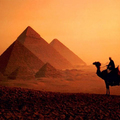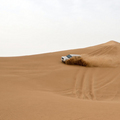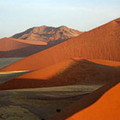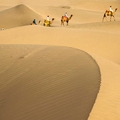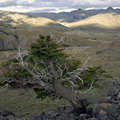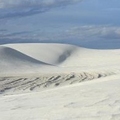Eco-friendly locations / The Largest Deserts in the World / The Kalahari Desert, Africa
The Kalahari Desert, Africa
The Kalahari Desert is located mainly in Botswana and its boundaries are the Orange River and the Okavango. The soil of the desert is covered with reddish grass and shrubs, in the east mostly sandy soil. On flat surfaces red and white sands that make up the gentle dunes. In the north there are woodlands, grasslands with acacias and baobabs. There is 1000 mm of rainfall per year. But the south is not as thick. The specy of tree which predomines in the desert is the shrub savanna. Then a semi-desert and desert landscapes give way. There is only 150 mm of precipitation per year. Kalahari is a desert in South Africa within the states of Botswana, South Africa and Namibia. In recent years, this area increased and intruded into the territory of Angola, Zimbabwe and Zambia. The Kalahari area is about 600 thousand km ². The climate of Kalahari is arid with maximum rainfalls and mild winters in summer, with increasing aridity to the south-east. The precipitations ( around 500 mm) are confined to the summer period (November - April), but their size varies considerably, both in time and in space.
Description
Kalahari is one of the hottest areas of South Africa. The maximum medium temperature is plus 29 °, and the minimum plus 12 °, 3 thousand volatility mm. The capital city is called the Kalahari in the west of Botswana - Ghanzi. The desert has pretty amazing flora. The desert climate is not conducive to the emergence of life in the Kalahari, but even here you can see a lot of interesting plant species. In the desert you can find the characteristic species of flora - thorny shrubs, many species of acacia, different kinds of herbs. Because of the prolonged droughts the plants have learned to adapt to severe environmental conditions. Some plants even have time to sprout and produce seeds in the four weeks of rain. Plants, in turn, are themselves an indispensable source of water for all animals. Woolly watermelon is a leader among those wells of the desert. There are: spotted and brown hyenas and aardwolves, honey badgers, etc. The common birds are: the pygmy falcon in the central and southern Kalahari desert that have sand grouse nests. In the southwest, in the most desolated landscapes there is the African thumb and there are also many lizards. The Kalahari Desert occupies 8% of the entire African continent. The man is accustomed to living among the dry and hot sand, ever-expanding, threatening to wake up and move. Kalahari is growing, moving in space and not obeying human laws. Now it willfully broke the barriers of Angola, Zambia and Zimbabwe. This is a huge realm of sand of about 600 thousand square kilometers with a variety of desert landscapes.
Others The Largest Deserts in the World .
Maps of The Kalahari Desert, Africa
mapOthers from The Largest Deserts in the World
Under such dry conditions it is hard for the plants to live and the soils to form.
There is anything that protects the earth from overheating in these areas.
The hottest place on the Earth is the tropical desert, but there are coldest , even icy deserts, for instance, Antarctica.
Deserts cover approximately 20% of the Earth's land surface and 80% in Australia , therefore, a fifth of the Earth's land area belongs to the deserts.
Many of the major deserts are located near the tropics, such as the Sahara desert which is the largest desert in the world, as well as the Kalahari, the Namib Desert and the Grand Victoria in Australia.
Droughts During the grazing of cattle during droughts disorders of vegetation occur.
They are so significant that are likely unrecovered.
The sun's rays quickly dry the soil and turn to dust, which happens to desertification, a continuous transformation of the land in the desert.
A desert with a change in climatic conditions can always shrink and expand.
The long-term global climate change or contraction of the continents can garden the desert or turn it into a magnificent forest.
Short-lived changes in weather conditions influence the expansion of its borders, turning occasionally green areas in arid deserts.
The hottest places on the Earth are the tropical desert, where the daytime temperatures often reach +50 ° C.
This heat can destroy the stones and give the landscape an unusual character.
The underground water evaporates so quickly that minerals are dissolved from the crust.
Deserts are constantly dry, but in other natural areas prolonged dry periods can occur - the droughts.
Their presence in any place depends on what kind of rainfall is there.
There was a drought in Sahel, Africa, that lasted many months without rain.
However, droughts are regular and in some places they are with a typical moisture content, such as the North American grasslands which dry up every 22 years.
Water plays a significant role in shaping the dry landscape, despite of its low quantity in the desert .
Water alters the chemical composition of rocks, now and then it is dumped in the desert from the sky, at times becoming the cause of short, but strong flash floods, which are harmful to the soil.
Do all the deserts have very high temperatures and a lot of sand? We call a desert an area where not more than 25 inches of rain falls per year.
As a rule, deserts are formed in the hot desert climates, but there are exceptions.
Most deserts have a lot of rocks and stones and sand.
What is the biggest desert? The most extensive deserts are located in areas of high atmospheric pressures.
All the winds blow in areas of their inner regions, but the moist winds from the sea reach them very rarely.
There are those deserts, which are near the sea, and yet the sea winds will reach them, they lose most of moisture on the way.
Certain deserts are formed on the internal continental slopes of mountain ranges, well sheltered from the sea winds.
Almost all of Antarctica is a huge frozen desert, which is located in an area of high pressure, so that its interior is extremely small drops of fresh snow.
The driest desert in the world.
In many deserts there is no rain for several years in a row, then a short downpour happens and everything starts all over again.
The most arid desert is the Atacama Desert in South America .
Until 1971, there were 400 years without spilling a drop.
It is known that in several places in the desert, there are artesian waters, but the high boron content makes them unsuitable for irrigation.
What is an oasis? An oasis is a plot of land in the desert, which is covered with vegetation.
It feeds from underground springs or natural wells.
The largest desert in the world The largest desert in the world is the Sahara Desert in North Africa.
Its area is of approximately 8400 sq.
km.
However, only ten percent of its territory is covered with sand, and everything else is taken by bare rocks and stones.
After Sahara, we have the Arabian desert, the Gobi, the Patagonian,the Rub’ al Khali, the Great Victoria, the Kalahari, the Great Basin, the Chihuahuan and the Thar.

